![]()
![]()
![]()
Use LEFT and RIGHT arrow keys to navigate between flashcards;
Use UP and DOWN arrow keys to flip the card;
H to show hint;
A reads text to speech;
19 Cards in this Set
- Front
- Back
- 3rd side (hint)
|
What was a major result of the Servicemen’s Readjustment Act of 1944 (GI Bill)? |
a. Millions of veterans received a college education. |
Militars begging to study |
|
|
Which development resulted from the construction of the interstate highway system? |
a. increased suburbanization |
|
|
|
How did the post–World War II baby boom affect American society between 1945 and 1960? |
c. It increased the need for educational resources. |
|
|
|
The information below describes some key provisions of the 1944 GI Bill of Rights. • Provided funds for education and training for veterans • Provided home, farm, and business loans for veterans • Provided unemployment compensation for veterans
Which sentence describes how post–World War II society was affected by the GI Bill of Rights? |
B. Economic success became available for a broader portion of society. |
|
|
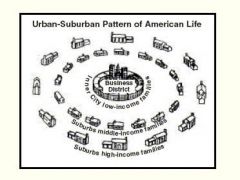
Which development following World War II caused the urban-suburban pattern shown in the diagram?
|
c. expansion of highways and automobile ownership |
|
|
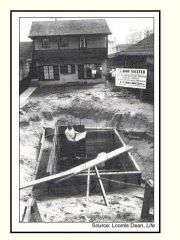
What does this photograph indicate about the United States in the 1950s? |
C. Much fear was created by the Cold War. |
|
|
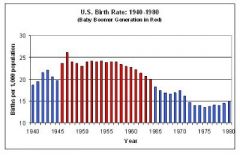
Which year represents the height of the baby boomer generation? |
c. 1947 |
|
|
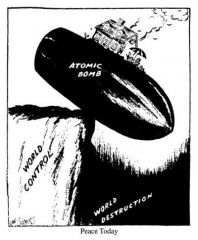
The main idea expressed in the cartoon involves the: |
B. problems created by the development of nuclear weapons |
|
|

This photograph shows the post–World War II growth that was typical of: |
B. suburban communities |
|
|
|
“This Government, as promised, has maintained the closest surveillance of the Soviet Military buildup on the island of Cuba. Within the past week, unmistakable evidence has established the fact that a series of offensive missile sites is now in preparation on that imprisoned island. The purpose of these bases can be none other than to provide a nuclear strike capability against the Western Hemisphere. . . .” — President John F. Kennedy, October 22, 1962
Which action did President Kennedy take following this statement? |
b. ordering a naval quarantine of Cuba |
|
|
|
… For the war against poverty will not be won here in Washington. It must be won in the field, in every private home, in every public office, from the courthouse to the White House.… — President Lyndon B. Johnson, State of the Union Address, January 8, 1964. This statement expresses President Lyndon B. Johnson’s view that the: |
d. entire country must help fight poverty |
|
|
|
Which development is most closely associated with the belief in the domino theory? |
a. military involvement in Vietnam |
|
|

How did President Lyndon Johnson believe these programs would change society? |
B. by promoting equal opportunity and reducing poverty |
|
|
|
". . . Let every nation know, whether it wishes us well or ill, that we shall pay any price, bear any burden, meet any hardship, support any friend, oppose any foe to assure the survival and the success of liberty." -Which conclusion is best supported by this quotation from the Inaugural Address of President John F. Kennedy in 1961? |
d. President Kennedy was encouraging a very strong presence in foreign policy in the post-World War II period. |
|
|
|
President John F. Kennedy supported the 1961 Bay of Pigs invasion of Cuba as an effort to: |
A. remove a communist dictator from power |
|
|
|
Which congressional bill gave President Johnson unprecedented power and the ability to use whatever means necessary to protect American interest & military bases in Vietnam |
a. Gulf of Tonkin Resolution |
|
|
|
The War Powers Act of 1973 was intended to affect the balance of power between the President and Congress by _______. |
d. placing limitations on the president’s ability to keep troops in hostile situations |
|
|
|
Which of the following best describes the counterculture of the 60’s and 70’s? |
a. Culture of the youth clashed with the establish, traditional culture. |
|
|
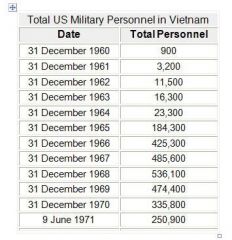
Between which two years did American military personnel in Vietnam escalate the greatest? |
d. 1965-1966 |
|

